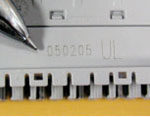5 June 2009
Laser Marking PBT Electrical Connectors
 One of the most significant thermoplastic polyesters engineered in the past 35 years, Polybutylene Terephthalate (PBT) exhibits a great surface finish, is dimensionally stable, and has excellent electrical insulation characteristics. When reinforcement is required, materials such as fibreglass, mica, stainless steel or carbon fibres, or other non-orienting fillers are added to the formulation. Today, PBT-based products are used in virtually every type of industrial, medical, and consumer application.
One of the most significant thermoplastic polyesters engineered in the past 35 years, Polybutylene Terephthalate (PBT) exhibits a great surface finish, is dimensionally stable, and has excellent electrical insulation characteristics. When reinforcement is required, materials such as fibreglass, mica, stainless steel or carbon fibres, or other non-orienting fillers are added to the formulation. Today, PBT-based products are used in virtually every type of industrial, medical, and consumer application.
The electrical connector shown here is manufactured from PBT and contains 30% glass fibre reinforcement. In addition to the engraved mark (typical of CO2 lasers), a dark contrast is produced by the reaction of the glass fibre to the laser beam, creating an easily readable, contrasting mark.
In many cases, when reinforcing filler materials are added to plastic formulations, CO2 lasers can create contrasting marks in a less expensive and much safer manner than shorter wavelength YAG lasers.
To achieve the cycle time required for this particular application, an FH Series marking head was selected with a 125 mm focusing lens (180-micron spot with a 3 mm depth of focus) to steer the beam from the Synrad sealed CO2 laser. An eight-character identification string was set-up in WinMark Pro Laser Marking software, using one of WinMark Pro''s fast marking stroke fonts. At a power level of 25 watts and a marking velocity of 635 millimetres per second (25 inches/second), each mark was created in a cycle time of only 0.14 seconds per connector.
- Contact Information
- Name: Gary Broadhead
- Email: garyb@laserlines.co.uk

